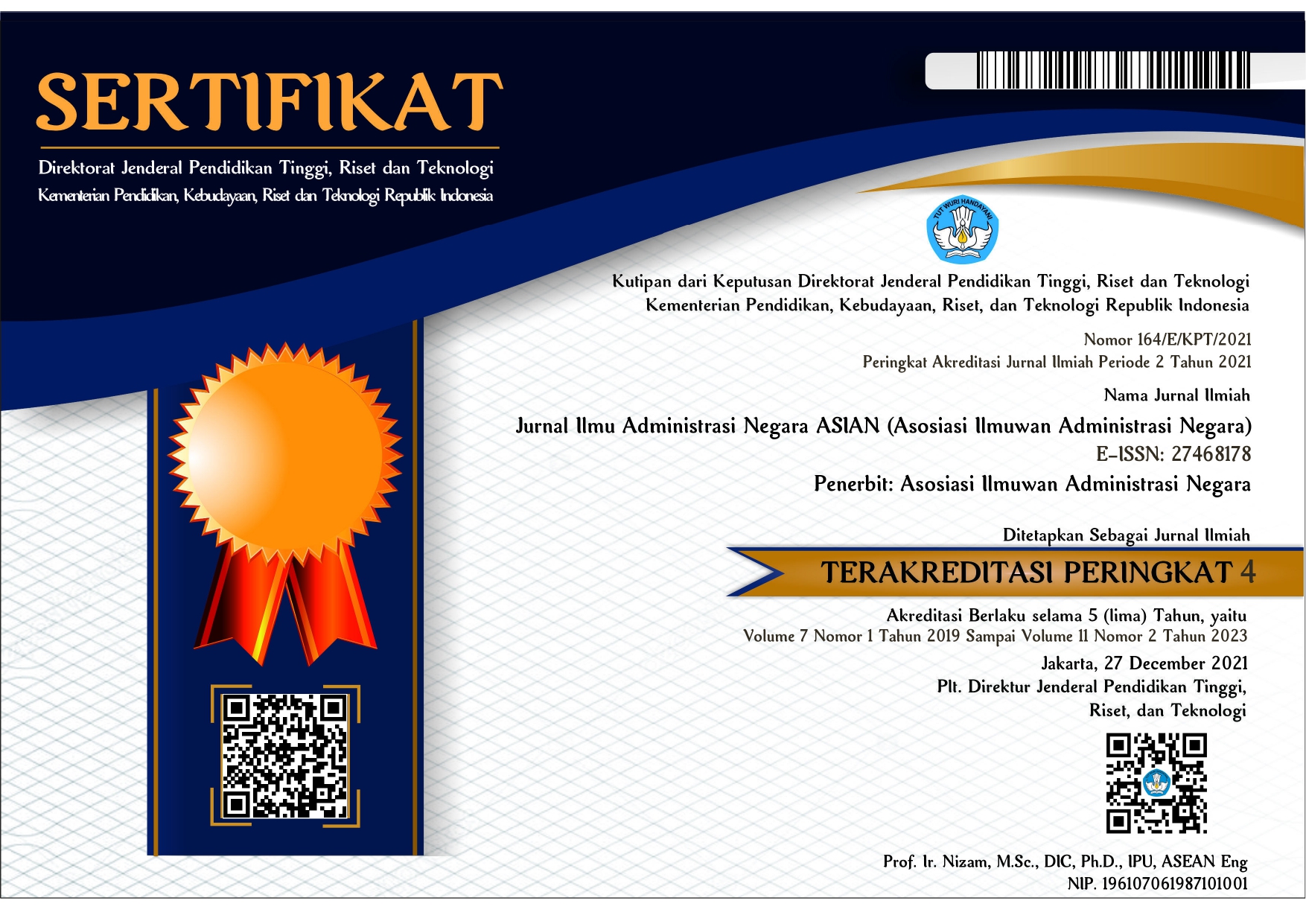Gaya Kepemimpinan Kepala Desa dalam Meningkatkan Produktivitas Kinerja Aparatur Desa
 Abstract views: 708
,
Abstract views: 708
,
 PDF downloads: 1114
PDF downloads: 1114
Abstract
The success or failure of the village can be seen from the leadership styles of the village leaders in increasing the productivity of its apparatus. The purpose of this study is to describe and analyze the leadership styles of village leaders in increasing the productivity of village leaders. In this type of qualitative research, the informants in this research are the village leaders and Sawo village officials. This research uses observation and in-depth interviews techniques to collect data. The focus of this research is on the leadership style of village leaders using a transformational leadership style or a transactional leadership style. Based on research findings, we can concluded that there are 2 leadership styles, namely transformational and transactional leadership. The most dominant leadership style used by the head of Sawo village is transformational leadership style. The leaders of Sawo village uses a transformational leadership style. This is proven by the fulfillment of transformational leadership style indicators. The leadership style of the village leaders is able to increase the productivity of the performance of his apparatus. It can be said to be increasing because looking at the performance of the apparatus, the quality and quantity of performance from year to year always increases.
Downloads
References
Andani, VD., Hayat, H., Sekarsari, RW. (2023). Kontribusi Kepemimpinan Trasformasional Terhadap Peningkatan Motivasi dan Disiplin Pegawai Melalui Sistem Aplikasi Manajemen ASN. Madani Jurnal Politik dan Sosial Kemasyarakatan, 15 (1).
Atika, N., Umiati, N., Hayat, H. (2018). Peningkatan Kinerja Aparatur Desa Dalam Melaksanakan Tugas Administrasi Desa Melalui Pendidikan dan Pelatihan. Civil Service Journal, 12 (1), 33-39.
Gunartin. (2020). Analysis of the Village Head’s Leadership Style in Cidokom Gunung Sindur Village Bogor District. Jurnal Ilmu Administrasi Publik, 10 (1), 75-84.
Hayat. (2014). Peningkatan Kualitas Sumber Daya Manusia Aparatur Pelayanan Publik Dalam Kerangka Undang-Undang Nomor 5 Tahun 2014 Tentang Aparatur Sipil Negara. Jurnal Keijakan dan Manajemen PNS, 8 (1), pp 3.
Siregar, A. (2019). Peran Kepemimpinan dalam Peningkatan Kinerja Pegawai Kantor Camat Sidikalang Kabupaten Dairi. Universitas Medan Area.
Wendari, N., Daswati., Tamher,fw. (2021). Gaya Kepemimpinan Kepala Desa di Kantor Desa Moahino Kecamatan Wita Ponda Kabupaen Morowali. Jurnal of Administrasion and Management Public Literation (JAMIL), 1 (1).
Bass. (1985). Leadership and Performance Beyond Expectation. New York: Free Press.
Bass. (1990). Handbook of Leadership: Theory, reasearch & managerial applications (3rd Ed). New York: Free Press.
Creswell, John W. (2016). Reseacrh Design: Pendekatan Metode Kualitatif, Kuantitatif dan Campuran. Edisi Keempat. Yogyakarta: Pustaka Pelajar.
Hayat, H., Malang, U. I., & Pendapatan, p. (2018). Buku Kebijakan Publik. Universitas Islam Malang, Indonesia.
Hayat, S. A. (2017). Manajemen Pelayanan Publik. Jakarta, PT. Raja Grasindo Persada.
UU No. 6 Tahun 2014 Pasal 1 Ayat 2 tentang Desa dan Pemerintah Desa.
Permendagri No.84 Tahun 2015 Pasal 6 Ayat 1 tentang Tugas dan Fungsi Kepala Desa
Sistem Informasi Desa Sawo https://sawo-dukun.desa.id/status-idm/2022.
Copyright (c) 2024 Jurnal Ilmu Administrasi Negara ASIAN (Asosiasi Ilmuwan Administrasi Negara)

This work is licensed under a Creative Commons Attribution-ShareAlike 4.0 International License.
Authors who publish with this journal agree to the following terms:
1. Copyright on any article is retained by the author(s).
2. The author grants the journal, right of first publication with the work simultaneously licensed under a Creative Commons Attribution License that allows others to share the work with an acknowledgment of the work’s authorship and initial publication in this journal.
3. Authors are able to enter into separate, additional contractual arrangements for the non-exclusive distribution of the journal’s published version of the work (e.g., post it to an institutional repository or publish it in a book), with an acknowledgment of its initial publication in this journal.
4. Authors are permitted and encouraged to post their work online (e.g., in institutional repositories or on their website) prior to and during the submission process, as it can lead to productive exchanges, as well as earlier and greater citation of published work.
5. The article and any associated published material is distributed under the Creative Commons Attribution-ShareAlike 4.0 International License








